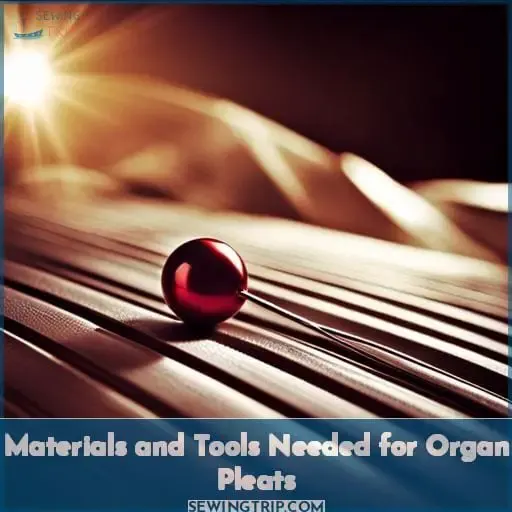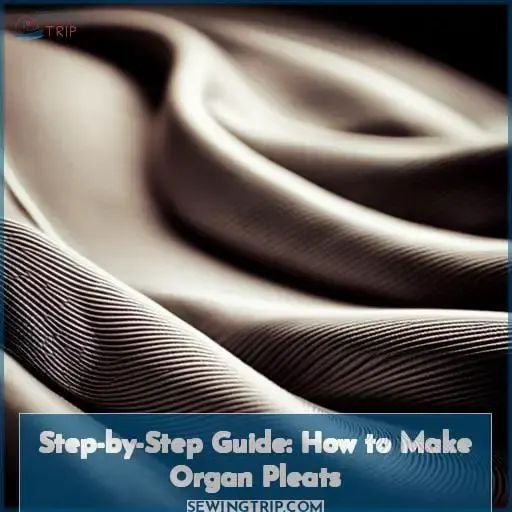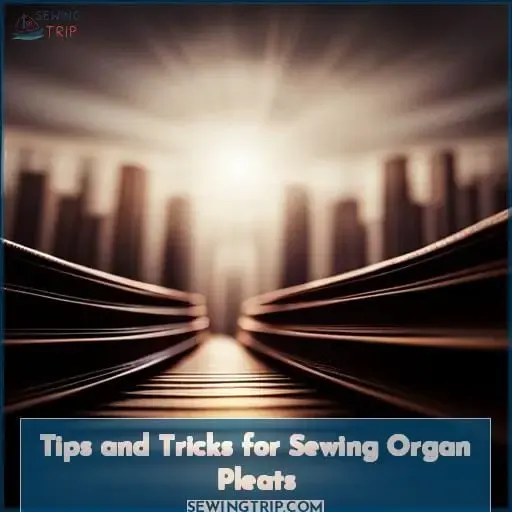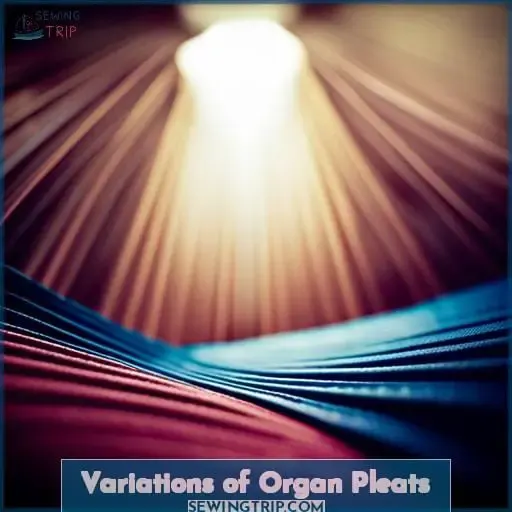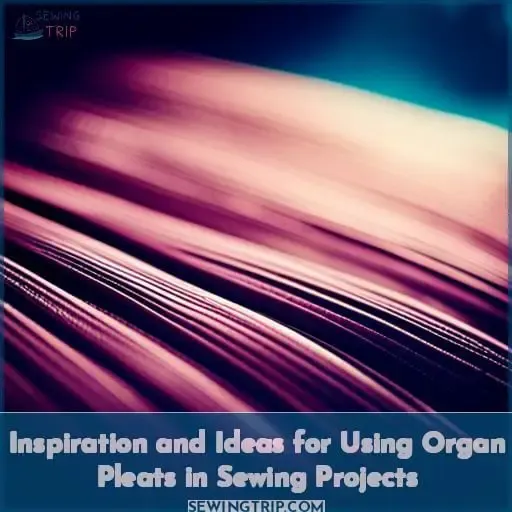This site is supported by our readers. We may earn a commission, at no cost to you, if you purchase through links.
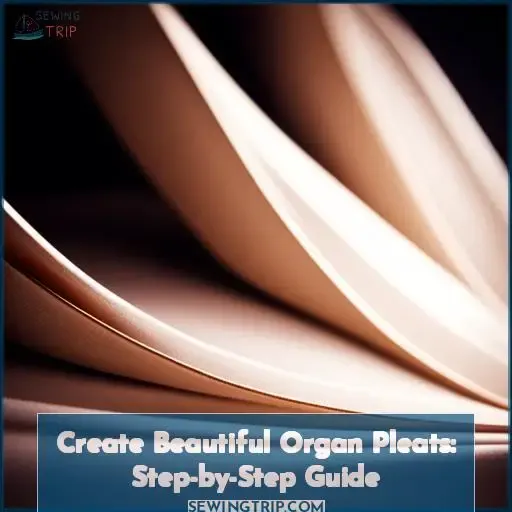 Unlocking the secrets of organ pleats is like untying a complex knot: intimidating at first glance, but actually quite simple when you know how. Whether you’re looking to create an elegant ball skirt or just add some flair to your wardrobe, mastering this technique can open up a world of possibilities for your sewing projects.
Unlocking the secrets of organ pleats is like untying a complex knot: intimidating at first glance, but actually quite simple when you know how. Whether you’re looking to create an elegant ball skirt or just add some flair to your wardrobe, mastering this technique can open up a world of possibilities for your sewing projects.
In this guide, we’ll take you step-by-step through the entire process so that even novice sewers can make stunning organ pleats with confidence and ease.
So grab those materials and tools needed for making beautiful organ pleats. Before long, even complete beginners will be creating their own modern masterpieces with pride.
Table Of Contents
- Key Takeaways
- Organ Pleats: a Unique and Elegant Technique
- Materials and Tools Needed for Organ Pleats
- Step-by-Step Guide: How to Make Organ Pleats
- Tips and Tricks for Sewing Organ Pleats
- Variations of Organ Pleats
- Common Mistakes to Avoid When Making Organ Pleats
- Inspiration and Ideas for Using Organ Pleats in Sewing Projects
- Conclusion
Key Takeaways
- The proper fabric choice is crucial for achieving the desired look of organ pleats.
- Methods like stitching and boning help support the pleats and maintain their form.
- Playing with variations in pleat sizes and different fabrics can generate unique and captivating effects.
- Meticulous spacing, folding, and careful creasing are required for executing well-formed organ pleats.
Organ Pleats: a Unique and Elegant Technique
You can achieve that striking silhouette with rolled organ pleats by following the 1895 tutorial’s instructions carefully. Play with the pleat measurements to build creative volume in your dresses and skirts.
Choose sturdy fabrics like brocade or taffeta that hold their shape well. Construct a lightweight petticoat to support the pleats without flattening them. Stitch boning horizontally underneath for added structure. Explore inverted box pleats too for stylish creations.
Manipulate the fabric using historical techniques but give it a modern, fun twist. With the right materials and support, your organ pleated garments will be head-turners.
Materials and Tools Needed for Organ Pleats
Gather your unwashed muslin, needles, and polyfill, for we embark on a journey to build pipe dreams.
- Unwashed muslin fabric – Using pre-shrunk fabric will inhibit the pipe structure. Go for unprocessed, raw muslin.
- Sewing needles – Invest in high quality, sharp needles like Schmetz 130/705H-SES. Dull needles can damage fabric.
- Polyester fiberfill – The fluffy stuffing provides structure. Choose a high loft fill for maximum pipe volume.
- Measuring tape – Precise pleat spacing is crucial. Do not eyeball it!
- Scissors – Sharp fabric scissors, like Gingher 8 dressmaker shears, make cutting smooth.
For daydreams of dramatic petticoats, the fabric selection and tools matter. With quality unwashed muslin, needles, fiberfill, measuring, and scissors, you’ve the basics covered. Beyond that, embrace creative variations like color blocking pleat sections or alternating stuffing materials.
Step-by-Step Guide: How to Make Organ Pleats
To create organ pleats, you’ll first want to prepare your fabric. Once your fabric is ready, mark and fold your pleats at equal intervals, then secure and stitch them down. Make sure to use a fabric appropriate for pleating and press or starch it so the folds will be crisp.
Measure out and mark the pleat placements before folding to keep them uniform. Pin the folds in place, then stitch along the creases using a straight stitch or a blind hem stitch on the interior side for an invisible look.
Be careful not to stretch the fabric as you sew. Hem or finish the raw edges once the pleats are secured to prevent fraying.
Preparing the Fabric
Before measuring and marking the fabric, wash it if needed to preshrink and remove any chemicals from manufacturing. To prepare for organ pleats, first decide on the desired spacing, such as 1-inch intervals.
Mark the fabric at those intervals along the length where you want the pleats. Consider different anchoring methods like stitching or boning to hold the pleats in place. Polyester fiberfill makes a light stuffing, but a roll of crinoline adds more structure.
You can explore varying the measurements or using heavier fabrics for different looks.
Marking and Folding the Pleats
With pleats newly marked, now courageously commence the meticulous folding.
- Precisely align each pleat’s seam line.
- Firmly crease folds using thumbnails.
- Check spacing between pleats for accuracy.
- Press folds firmly to set pleat structure.
Meticulously fold the pleats along the marked seam lines. Firmly crease each fold, aligning the pleat seam lines precisely. Regularly check pleat spacing for accuracy as you progress. Press folds firmly to set the pleat structure before moving to the next steps.
Securing and Stitching the Pleats
Once the pleats are folded and positioned, anchor each one down its center with a straight stitch using a fine needle and thread. Consider lighter or stiffer fabrics when determining the stitch length, as thinner fabrics may require a shorter stitch, while heavier fabrics can support a longer one.
Play with different stitching techniques like zigzag or decorative patterns to make the pleats a unique focal point.
| Stitching Technique | Description |
|---|---|
| Straight Stitch | Basic anchoring stitch down pleat center |
| Zig-Zag Stitch | Decorative variation for added interest |
| Buttonhole Stitch | Creates defined holes for a lacy look |
| Decorative Patterns | Get creative with shapes or words |
| Contrasting Threads | Make the stitching pop with bold colors |
Pleat styles allow ample room for creativity. You can experiment with different stitching methods to make your design stand out. The possibilities are endless when approaching sewing with an open and inspired mindset.
Tips and Tricks for Sewing Organ Pleats
When working with organ pleats, choosing the right fabric is crucial for achieving the dramatic volume you desire. Proper stitching techniques like anchoring the folds and providing hidden support will assist in maintaining the pipe-like shape, while structural elements such as crinoline cages or boning can prevent the pleats from collapsing.
Varying your stitch length and alternating long and short stitches can help secure the pleats. Consider lightweight fabrics like silk or cotton voile that will hold a crisp pleat. Interfacing or stabilizer can be used to add body and support to the fabric. Take care not to catch the pleat folds when stitching to allow them to hang freely.
Baste the pleats first to ensure even spacing before sewing them down permanently.
Choosing the Right Fabric
You’ll want a sturdy fabric with nice drape for those voluminous pleats. Consider unwashed silk taffeta, silk shantung, or dupioni. Their crisp hand will hold pleats yet give that lovely sheen. Stitching behind the folds provides internal structure too.
Play with different widths and depths for diverse looks. Needle and thread sculpt these pipes. What unique designs will you dream up? Historical revivals inspire, but make it your own.
Using Proper Stitching Techniques
When sewing organ pleats, be sure to anchor the folds with small stitches and maintain uniform spacing between pleats for best results.
- Use a fine needle like a 12/0 for tiny anchoring stitches.
- Keep stitches 1-2mm long to secure without visibility.
- Mark pleat spacing intervals on the fabric before folding.
- Frequently check the spacing as you work.
Proper stitching techniques enable organ pleats that stand up beautifully without pressing, opening decorative possibilities for period garments.
Creating Support for the Pleats
While pleat support sounds tricky, you are clever enough to figure out a solid solution. Consider supportive structures like a crinoline cage or vertical boning. Stitching horizontal threads behind pleats adds stability as well.
Do not forget historical references. Charles James used steel tape and hair cloth for structure. Experiment with different materials and methods until you find the ideal support system.
Variations of Organ Pleats
Let’s explore some creative ways to vary organ pleats. You can alternate between 1-inch and 2 1⁄4-inch pleats for visual interest. Try changing up the spacing between pleats or experimenting with heavier fabrics like wool to see the effects on volume and structure.
Just remember to maintain symmetry and order in your pleat variations for the best visual impact. Organ pleats allow plenty of room for creativity in materials, sizes, and spacing while still forming that eye-catching pipe-like shape.
Alternating Pleat Sizes
Sew alternating 1 and 2 1⁄4 inch pleats for dramatic volume down the skirt.
- Experiment with different pleat sizes like 1 and 3.
- Try creating a gradient, going from small to large pleats.
- Use stiff fabrics like brocade or quilted materials to hold the pleats.
- Baste first to double check sizing and spacing before sewing.
- Showcase the pleats with slits or open skirt styles.
Mix up pleat sizes and fabrics for exciting textures on your skirt. Go bold with varying widths or subtle with a graduated pattern. Verify proportions before permanent sewing and highlight with creative designs. Pleats allow you to shape unique silhouettes.
Varying Pleat Spacing
You can experiment with uneven pleat spacing for visual interest. Get creative with the spacing between pleats. Try clusters of narrow pleats mixed with wider gaps. This adds intrigue through asymmetry and uneven rhythm.
Be bold and break the rules! Play with different sizes and spacing until it excites your inner designer. The uneven negative spaces will make basic pleats extraordinary. Embrace the sewing challenges of irregular pleat placement.
Let the fabric and design possibilities guide you. Consider the uneven pleat spacing and how it impacts the overall look. Focus on making each section purposeful yet unique. Surprise yourself and push past convention.
Experimenting With Different Fabrics
Fabrics with different textures lend a distinct look and feel to organ pleats. Try varying silk weights and textures for elegant drape and movement. Incorporate eye-catching brocades, raw silks, satins, or crepe de chine for intriguing pattern and texture interplay.
Adapt sizing to account for less stiffness. Combine metallics, bold prints, and rich solids for dramatic color and visual impact. Allow for tricky handling. Consider stabilization to prevent sagging. Experiment with unexpected textile mixes.
Common Mistakes to Avoid When Making Organ Pleats
When working with organ pleats, avoid some common mistakes for the best results. Choosing the wrong fabric, inaccurate measuring and marking, and not properly securing the pleats can lead to a sloppy and misshapen garment.
Instead, carefully select a crisp, structured fabric like organza or faille. Precisely measure and mark the placement of the pleats.
Using the Wrong Type of Fabric
Your quest for dramatic volume risks disastrous defeat if the fabric proves too flimsy for the mighty organ pipes. Even with flawless folding and stitching, lightweight fabrics simply lack the structure to uphold voluminous folds.
Stay clear of chiffons, charmeuse, and other clingy fabrics. Opt for sturdy cottons or stiff silks to successfully sculpt your organ pipe fantasy into reality. Wool suitings and brocades prove ideal textile choices for conquering the challenge of crafting substantial, self-supporting pleats that last.
Inaccurate Measurement and Marking
Marking off exact intervals is crucial for these pleats or they’ll appear uneven.
- Use sharp tailor’s chalk and a ruler for precision.
- Mark both sides of the fabric to verify alignment.
- Check each measurement twice before cutting or sewing.
- Use vanishing pen for delicate fabrics.
- Practice on scrap material first.
Without meticulous measuring and marking, the spacing and heights of the organ pleats can easily go awry, resulting in a crooked look.
Not Securing the Pleats Properly
You’ll want to ensure those pleats are stitched down securely so the structure doesn’t collapse. Proper anchoring prevents pleat shifting. Reinforce each fold at the waistline with sturdy stitching. Use strong thread and small stitches for maximum hold. Consider adding lightweight interfacing or thin boning too.
Pleat structure needs fortification against gravity’s pull. Secure pleating liberates the fabric’s form.
Inspiration and Ideas for Using Organ Pleats in Sewing Projects
After avoiding some common mistakes, it’s time to get inspired about the possibilities with organ pleats! Let your creative fashion vision run wild as you imagine all the stylish ways to incorporate this unique detail.
Design a bold evening gown with voluminous organ pleats cascading down the skirt. Or create a whimsical blouse by concentrating tiny pleated accents on the sleeves and collar.
For minimalist chic, try a simple sheath dress with subtle organ piping tracing the waistline. The options are endless when you view organ pleats as an artistic element to enhance your sewing.
Don’t just relegate them to formal looks – get inspired to use organ pleats in unexpected mixes and combinations.
Conclusion
Organ pleats are a timeless and sophisticated way to add grace and movement to a garment. From the subtle shaping of a box pleat to the dramatic volume of an organ pleat, the ability to make each of these pleats is a must-have skill for any seamstress.
With the right materials and tools, the creation of organ pleats is an achievable task. With a bit of patience and practice, you’ll be able to craft beautiful organ pleats that provide a stunning visual impact.
Whether you’re creating a garment for a special occasion or just want to add a unique touch to your wardrobe, learning how to make organ pleats is a skill that will serve you for years to come. So, step up your sewing skills and take on the challenge of mastering the art of making organ pleats.


